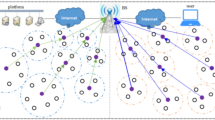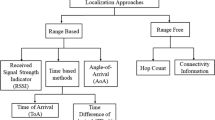Abstract
Data gathering is a major function of many applications in wireless sensor networks. The most important issue in designing a data gathering algorithm is how to save energy of sensor nodes while meeting the requirements of special applications or users. Wireless sensor networks are characterized by centralized data gathering, multi-hop communication and many to one traffic pattern. These three characteristics can lead to severe packet collision, network congestion and packet loss, and even result in hot-spots of energy consumption thus causing premature death of sensor nodes and entire network. In this paper, we propose a load balance data gathering algorithm that classifies sensor nodes into different layers according to their distance to sink node and furthermore, divides the sense zone into several clusters. Routing trees are established between sensor node and sink depending on the energy metric and communication cost. For saving energy consumption, the target of data aggregation scheme is adopted as well. Analysis and simulation results show that the algorithm we proposed provides more uniform energy consumption among sensor nodes and can prolong the lifetime of sensor networks.
Similar content being viewed by others
References
Akyildiz, I. F., Su, W., Sankarasubramaniam, Y., & Cayirci., E. (2002). Wireless sensor networks: a survey. In Computer Networks (pp. 393–422).
Cerpa, A., Elson, J., Estrin, D., Girad, L., Hamilton, M., & Zhao, J. (2001). Habitat monitoring: application driver for wireless communication technology. In Proceedings of ACM SIGCOMM workshop on data communications in Latin America and the Caribbean (pp. 3–5).
Israr, N., & Awan., I. (2008). Coverage based inter cluster communication for load balancing in heterogeneous wireless sensor networks. Telecommunications System, 121–132.
Hassanein, H., & Luo., J. (2006). Reliable energy aware routing in wireless sensor networks. In Proceedings of the 2nd IEEE workshop on dependability and security in sensor networks and systems (pp. 54–64).
Park, J., & Sahni., S. (2006). An online heuristic for maximum lifetime routing in wireless sensor networks. In Proc. IEEE trans. Comput. (pp. 1048–1056).
Wang, L.-C., Wang, C.-W., & Liu., C.-M. (2005). An adaptive contention windowbased cluster head election mechanism for wireless sensor networks. In Proceedings of the IEEE vehicular technology conference, 2005 Fall (pp. 56–60).
Tubaishat, M., & Madria., S. (2003). Sensor networks: an overview. In IEEE potentials (pp. 20–23).
Lindsey, S., Raghavendra, C., & Sivalingam, K. (2002). Data gathering in sensor networks using the energy-delay metric. IEEE Transactions on Parallel and Distributive System, 924–935. Special Issue on Mobile Computing.
Heinzelman, W. R., Chandrakasan, A., & Balakrishnan, H. (2000). Energy-efficient communication protocol for wireless microsensor networks. In Proceedings of the Hawaii international conference on system sciences (pp. 113–121).
Lindsey, S., & Raghavendra, C. (2002). PEGASIS: Power-efficient gathering in sensor information systems. In IEEE aerospace conference (pp. 1125–1130).
Heinzelman, W. R., & Chandrakasan, A. (2002). An application specific protocol architecture for wireless microsensor networks. IEEE Transactions on Wireless Communications, 660–670.
Lee, S. H., Yoo, J. J., & Chung, T. C. (2004). Distance-based energy efficient clustering for wireless sensor networks. In Proceedings of the 29th annual IEEE international conference on local computer networks (pp. 118–126).
Mhatre, V., & Rosenberg, C. (2004). Homogeneous vs heterogeneous clustered networks: a comparative study. In Proceedings of IEEE ICC 2004 (pp. 34–38).
Younis, O., & Fahmy, S. (2004). Distributed clustering in ad-hoc sensor networks: a hybrid, energy-efficient approach. In Proceedings of IEEE INFOCOM (pp. 633–640).
Xue, Q., & Ganz, A. (2004). Maximizing sensor network lifetime: analysis and design guides. In Proceedings of MILCOM (pp. 233–237).
Chan, H., & Perrig, A. (2004). ACE: An emergent algorithm for highly uniform cluster formation. In Proceedings of the first European workshop on sensor networks (EWSN) (pp. 66–71).
Ye, M., Li, C. F., Chen, G. H., & Wu, J. (2004). EECS: an energy efficient clustering scheme in wireless sensor networks. In Proceedings of the IEEE international workshop on strategies for energy efficiency in ad hoc and sensor networks (IWSEEASN’05) (pp. 44–48).
Shah, R. C., & Rabaey, J. M. (2002). Energy aware routing for low energy ad hoc sensor networks. In Proc. of the 3rd IEEE wireless communication and networking conf. (WCNC) (pp. 151–165).
Perillo, M., Zhao, C., & Heinzelman, W. (2004). On the problem of unbalanced load distribution in wireless sensor networks. In Proc. of the IEEE GLOBECOM workshops on wireless ad hoc and sensor networks (pp. 74–79).
Hill, J., Szewczyk, R., Woo, A., Hollar, S., Culler, D. E., & Pister, K. S. J. (2002). System architecture directions for networked sensor. In Architectural support for programming languages and operating systems (pp. 93–104).
Rappaport, T. (1996). Wireless communication: principles and practice (pp. 221–246). New York: Prentice Hall.
Author information
Authors and Affiliations
Corresponding author
Rights and permissions
About this article
Cite this article
Guan, X., Guan, L., Wang, X.G. et al. A new load balancing and data collection algorithm for energy saving in wireless sensor networks. Telecommun Syst 45, 313–322 (2010). https://doi.org/10.1007/s11235-009-9269-3
Published:
Issue Date:
DOI: https://doi.org/10.1007/s11235-009-9269-3




